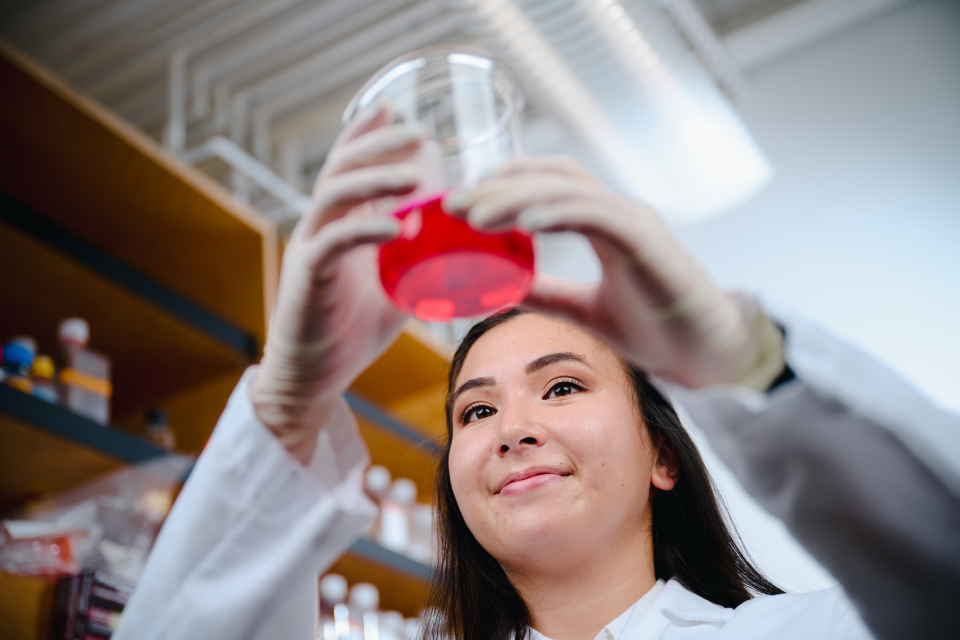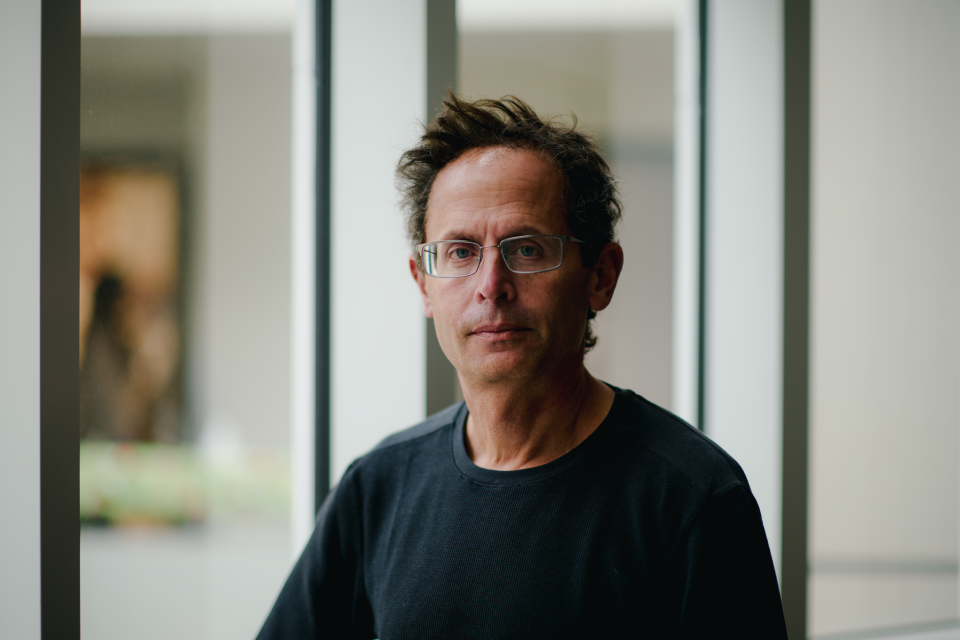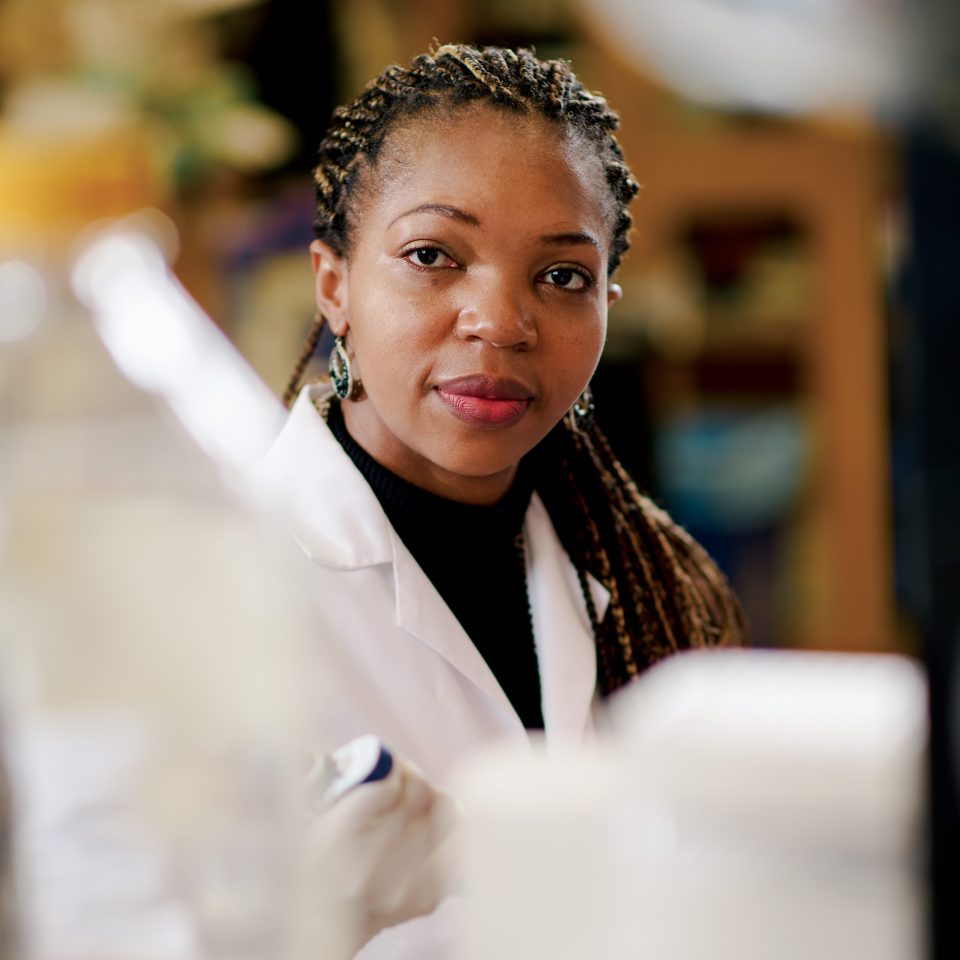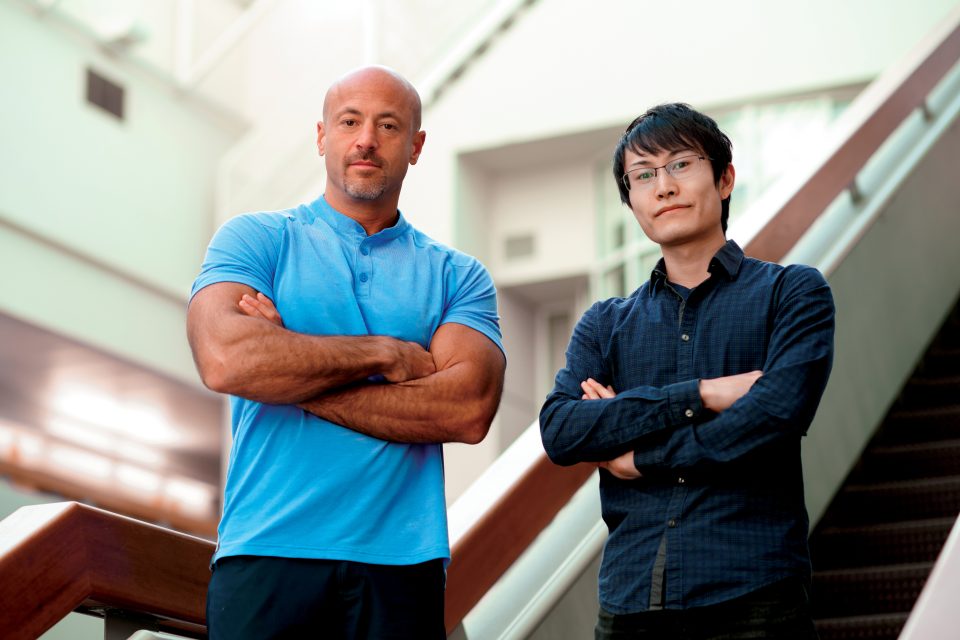
Scripps Research chemists drive innovation across the spectrum of science, industry and medicine.
“If we can develop a new reaction that didn’t exist before, we may reduce 10 steps of synthesis into one step. That will dramatically reduce the amount of waste and labor, and medicines can be made in a cheaper and more sustainable way.”
—Yu Kawamata, PhD | Scripps Research
Maya Bulos remembers the day in middle school when she received a harsh lesson about the disappointments of the human body. Her parents told her that her father suffered from the debilitating inflammatory bowel disease Crohn’s and was being forced to retire in his late 30s.
Like any child feeling helpless in the face of a parent’s illness, she wished she knew how to help him. Although her father is now in remission, the experience left Bulos with a deep desire to understand what goes wrong on a cellular level to make people sick.
Today, Bulos, a graduate student at Scripps Research and recipient of the Skaggs Fellowship Endowment in Molecular Medicine, is studying what’s known as the Hippo signaling pathway, a process that controls the cell growth and size of our organs. She and her colleagues in biochemist Michael Bollong’s lab are on the hunt for small molecules that could override the Hippo pathway. These could allow tissue to regenerate—ideally making it possible for heart attack patients to repair their own damaged muscles, burn victims to grow new skin or people with Crohn’s or ulcerative colitis to heal their inflamed intestines.
“I’ve always wanted to study science that directly impacts human health,” says Bulos, who came to the institute in the summer of 2020. “Scripps Research does this kind of work.”
Hers is a classic Scripps Research chemistry story. Her research treating cells with compounds to see how they affect the Hippo pathway is the kind of critical basic science that paves the way for potential future breakthroughs.

“We do the foundational science of drug discovery here,” says Professor Ben Cravatt, PhD, whose lab applies knowledge about how proteins alter cellular functioning to identify new druggable targets and drug candidates. Other Scripps Research scientists explore the most promising insights to see if they can turn those discoveries into therapeutics, as part of the institute’s unique “bench to bedside” drug creation model.
It’s a winning formula that has earned Scripps Research recognition by Nature Index as the most innovative research institution in the world, home to Nobel laureates and MacArthur Fellows. This approach has also put the institute’s chemists at the forefront of translational research, as the biomedical industry exploded over the last decade, especially in San Diego.
Yet the idea that chemists’ work should have real-world impact has long been part of the institute’s ethos. After the late scientist Richard Lerner, MD, took the helm as director and president of Scripps Research in 1987, he established the institute’s chemistry department and the Skaggs Graduate School of Chemical and Biological Sciences, which was soon ranked among the top 10 U.S. graduate programs. The school quickly developed a reputation as a powerhouse of biomedical research that led to practical applications, thanks to its interdisciplinary focus and Lerner’s unprecedented partnerships between industry and academia. During his 25-year tenure, his work was instrumental in creating the landmark drugs Humira® for arthritis and Benlysta for lupus.
With the ability to remotely monitor an individual’s vital signs—such as respiratory function, heart activity and body temperature—scientists and clinicians can gather key patient data and change treatment plans even from thousands of miles away.

“Richard created an environment that enabled innovation and groundbreaking science, and a major aspect of that was building a world-class chemistry department that is central
to advancing biology and medicine,” says Peter Schultz, PhD, the current President and CEO of Scripps Research.
The list of accolades continues to grow: Among the institute’s track record of producing 10 drugs approved by the U.S. Food & Drug Administration, the transformational drug tafamidis for a rare heart disease and associated nerve dysfunction caused by abnormal protein deposits was the brainchild of Scripps Research chemist Jeffery Kelly, PhD, the Lita Annenberg Hazen Professor of Chemistry. Awarded the $3 million Breakthrough Prize last fall, Kelly studied how the protein transthyretin can produce clumping that destroys cells and tissues earlier in his career and eventually discovered the molecule that slows down that process.
Another Scripps Research success story is the recent approval of the drug ozanimod for multiple sclerosis and inflammatory bowel disease. That’s not to mention the many companies, such as ActivX, Abide and Vividion Therapeutics, that have spun out of Scripps Research labs with the goal of commercializing those insights into drugs for unmet medical needs across many categories of diseases. Or the researchers at the institute’s 135 active labs who are also making significant impacts outside of medicine in fields as varied as materials science, industry and green chemistry.
The innovations don’t end there: Scripps Research’s drug discovery division Calibr, which harnesses the power of combinatorial chemistry and cutting-edge automation, is translating promising ideas from the institute’s academic labs into real-world therapies. Founded by Schultz, Calibr has ushered six medicines into human clinical trials and has many more moving through its rich pipeline. Calibr’s new programs focus on cancer immunotherapies and regenerative medicines for lung, intestinal and joint disorders that repair the damage caused by disease. Researchers have also made significant contributions to better understanding COVID-19 antivirals, HIV and malaria vaccines, and therapies for neurodegenerative disorders like Alzheimer’s and Parkinson’s that enlist the body’s own defense mechanisms. These advances have led to alliances with major pharmaceutical companies, the Bill & Melinda Gates Foundation in Seattle, and Wellcome Trust in London.
“I communicate to all our students and postdocs that it’s a special time to be a scientist,” says Cravatt. “At no previous time in the history of science have we had this much understanding about the molecular basis of human disease.”
A Pioneer in Integrating Chemistry and Biology
When Cravatt first joined Scripps Research nearly 30 years ago to pursue his doctorate, he was attracted to the institute’s philosophy of integrating chemistry and biology, which has emerged as one of the institute’s unique strengths.
“Coming to Scripps Research was a huge blessing. In the mid ’90s, it was the first place to have an interfacing program like this,” says Cravatt, who holds the Gilula Chair of Chemical Biology. “Scripps Research had put down in writing what I wanted to do before I even knew how to independently articulate it.”
The institute provided the opportunity to use organic chemistry tools in new ways to study human cells and then harness that knowledge to connect the dots to a potential medicine. Lerner’s vision was prescient, says Cravatt. This interdisciplinary approach turned out to be valuable for taking advantage of all the genetic sequencing data that would become available over the last decade.

“At Scripps Research, I like the diversity of people and research projects. Everyone is such a powerhouse and so smart, but they’re happy to answer questions. It’s recognized that we’re all here to learn so we all grow together.”
—Evert Njomen, PhD | Cravatt Lab
One of the biggest challenges of the current genomics age is figuring out how to find drugs to target the windfall of newly identified genes that are linked to specific diseases. Cravatt’s lab aims to integrate the genetic information of human disease with cell and animal models to identify the underlying biochemical defects and then pinpoint an effective small molecule to correct the impaired pathways. This work has required the development of advanced technologies that enable screening of diverse proteins for interactions with small molecules directly in human cells.
“Much of our knowledge of genetic disease isn’t actionable. A doctor can say your cancer is caused by a specific oncogene, or your rare neurological disorder is due to the loss of this protein, but they don’t yet have a way to treat these diseases,” says Cravatt. “We’re interested, for instance, in developing ways to precisely target cancers that have known molecular drivers. We want to be able to say, ‘Here’s the drug that matches your specific disease.’ That’s the goal.”
A Culture of Collaboration
The institute’s commitment to bridging the two disciplines doesn’t just pay off in new insights that will guide the next generation of drug development. It also sets a standard for a collegial work environment that’s appreciated by the next generation of science leaders.
“Chemical biology is collaborative in nature, and I’m impressed by how humble and respectful people are of each other,” says Evert Njomen, PhD, a postdoctoral research associate who was hired by Cravatt in 2019. “At Scripps Research, I like the diversity of people and research projects. Everyone is such a powerhouse and so smart, but they’re happy to answer questions. It’s recognized that we’re all here to learn so we all grow together.”
Bulos agrees. “I really like the lab community,” she says. “Most of us sit in one office, and we’re always there to troubleshoot and support each other when things are not going well. We also cheer each other on.”
“Richard Lerner created an environment that enabled innovation and groundbreaking science, and a major aspect of that was building a world-class chemistry department that is central to advancing biology and medicine.”
—Peter Schultz, PhD | Calibr, Scripps Research
Njomen, who’s originally from Cameroon, came to the United States for graduate school because her undergraduate university there didn’t offer many opportunities to do research. She’d planned to be a physician, but while studying chemistry and pharmacology at Michigan State University, she become fascinated by the role of chemistry in solving biological questions.
Njomen was curious how the body removes proteins that are no longer useful and wanted to learn more about how cellular functioning contributes to different diseases. “I had this awakening. My parents always wanted me to be a doctor, but I realized research was more exciting to me.”
At Scripps Research, Njomen, a recipient of the Howard Hughes Medical Institute Hanna H. Gray fellowship, is following her passion by studying how cells get rid of proteins and invading pathogens, such as bacteria and viruses—a process known as “autophagy.”
“Think of it like a garbage disposal,” she says. Her work focuses on developing platforms to find small molecules that can boost the autophagy process to clear viruses and bacteria from the body.
“We have to study autophagy in a native system. Here’s where Scripps Research’s technology is important,” says Njomen, referring to a new generation of scientific tools called chemical proteomics that allow researchers to identify protein targets of small molecules that could lead to blockbuster drugs. “Our hope is that by boosting our own natural immune system, we may be able to fight a variety of pathogens with just one small molecule drug.”
Making New Matter
Just as Scripps Research has become a leader in studying how chemistry can impact the natural body in all its mystery and limitations, other chemists at the institute are exploring ways to create new things entirely to solve big problems. The field of synthetic organic chemistry focuses on improving the way scientists make molecules or invent new types of molecules.
Last fall, The Welch Foundation, one of the nation’s largest sources of private funding for chemical research, recognized longtime professor Chi-Huey Wong, PhD, with the prestigious Robert A. Welch Award in Chemistry for his pioneering work synthesizing carbohydrates and glycoproteins, which led to a vaccine targeting the surface of cancer cells.
Wong developed tools that synthesized glycans, complex sugars that are involved in the body’s ability to create new cells or respond to viral threats but notoriously difficult to study. By performing a kind of alchemy that isolated glycans from interacting with other cells, he enabled researchers to be able to observe how sugars function in the body more accurately and laid the groundwork for the development of vaccines and drugs for influenza, cancer and HIV.
Another synthetic chemistry luminary, K. Barry Sharpless, PhD, W.M. Keck Professor of Chemistry, discovered the chemical reactions that allowed larger molecules to snap together easily—a phenomenon called “click chemistry.” (This was in 2001, the same year he won the Nobel Prize in Chemistry for other chemistry advances.) That breakthrough led to the first protease inhibitors that helped turn HIV from a death sentence into a manageable disease. It also inspired researchers to create libraries of drug molecules and potential drugs for diabetes, Alzheimer’s, Parkinson’s, cancer and many other diseases.
In the lab of Phil Baran, PhD, Senior Staff Scientist Yu Kawamata, PhD, is tackling the problem of chemical waste that’s often generated during the production of pharmaceuticals. Take the pain reliever ibuprofen, for example. It’s manufactured through multiple steps—each involving different chemical reactions and a byproduct.

“This isn’t really a sustainable way to make medicines because all this waste causes environmental problems,” says Kawamata, who joined the institute as a postdoctoral research associate in 2016.
One way to shorten the process of manufacturing ibuprofen is through a technique called “electrolysis,” which uses the power of electricity to make chemical changes. Electrolysis is one of the most economical ways to add or remove electrons from molecules during chemical reactions, and Baran’s team has pioneered a number of techniques for using electrochemistry to synthesize them more efficiently.
“If we can develop a new reaction that didn’t exist before, we may reduce 10 steps of synthesis into one step,” says Kawamata. “That will dramatically reduce the amount of waste and labor, and medicines can be made in a cheaper and more sustainable way.”
Once Kawamata and his team fine-tune the basic science, the synthesis method could be used in other products, such as agrochemicals, perfumes, plastics and electronic materials.
“I believe this technique has many applications, and I was enthusiastic to be able to come study here,” he says. Not only is Kawamata a fan of the institute’s Pacific Ocean views, but he also values the institute’s flexibility to explore new research directions and projects.
That open-mindedness is an important factor behind Scripps Research’s prominence, explains Baran, a recent MacArthur Fellow who holds the Darlene Shiley Chair in Chemistry.
“We have the freedom to explore without extraneous bureaucracy or constant meetings. Our institutional directive is simply to do something useful,” he says. “The ability to jump from topic to topic is a real blessing because there’s so much to discover.”
During his two decades at Scripps Research, Baran says he is proud of the hundreds of graduate students and postdocs who’ve worked in his lab, added insights to the foundations of organic chemistry and then spread that knowledge to industry or academia.
“What the public doesn’t realize,” says Baran, “is that they’re the invisible, passionate army of dedicated scientists that make all our lives better.”